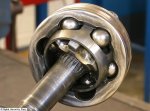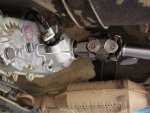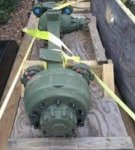Also the "D" upgrade switched out bearing cup straps for the bolt on bearing caps as well as a 4" diameter shaft vs the 3" original so pretty quick to spot and verify the fix in addition to the big D on the data plate.
I read that entire test and evaluation report a while ago. As I recall the best solution, that wasn't used by the way, was the BAE solution with a driveshaft that had the ball and socket type joint (can't recall the name) that is the same type of shaft on the current Jeep wranglers.
UPDATE- Apologize at writing my truck is 150 miles away thus could not look to verify if Yoke on T-case was machined to shaft or installed on splines. After much study of pictures and Parts book now confident to say they are on splines. Below updated accordingly
CV Joint (Constant Velocity). On these trucks the yoke is slipped onto output shaft of Tcase and bolted so it is just a matter of $$$, taking measurments and having a driveshaft made with Rzeppa style joints on each end. I've contaced GDK for part numbers of the joints they used but they've not responded.
Rzeppa style CV joint on end of a shaft.

goal is to end up with more flexable joint like this

on each end that does not translate forces into the Tcase and alxle as much as a typeical Ujoint does.
Note: Last photo is NOT exact (wrong joint pictured) but visually more self explanitory cause Rzeppa ball ends when installed are incased. Thus, actual shaft ends would be of Rzeppa CV type like pictured earlier; not Double Cardan CV shaft as shown
So without a huge market what do yall think??? To have a shaft made up, 1 grand? (may be WAYYYYYYYY off on that.) Sell price would be similar again cause not a big market????
For more tech info see.....
http://www.billavista.com/tech/Articles/Driveshaft_Bible/index.html
Has anyone seen or have a good pic of the driveline proposed in the study. The PDF's pic. of the highest rank (Rzeppa type) shaft is not distinguishable in any of the PDF's have seen so far.







